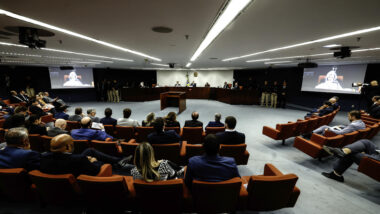The framework of the Homicide Unit of Curitiba is insufficient to solve the large amount of murders committed in the city. Under pressure, aware of the gap that exists between the hundreds of homicides that take place every year and their working conditions, police officers themselves claim in some legal documents that doing their job is "an impossible task". As a result, a lot of inquiries remain uncompleted and stay in drawers and on tables for months at the police station, unsolved.
The issues begin with the lack of personnel. On top of the police chief in charge of managing the unit, there are only four deputy-sheriffs taking part in the investigation of the crimes. As there were 597 murders in Curitiba in 2012, according to the State of Paraná Secretary for Public Safety (SESP), every sheriff had to deal with 120 cases over the year. This means that each sheriff had three days to solve a murder this not counting the periods of holidays, leaves and breaks of every professional and not considering the pending inquiries at the time of the study.
Continual TurnoversContinual turnovers of sheriffs are another issue. Out of the one thousand deaths analyzed by the reporters of Gazeta do Povo, only 35.1% had only one sheriff investigating since the beginning of the case. Out of the other 649 remaining cases, 166 had had between four to seven sheriffs investigating.
Prosecutor Marcelo Balzer Correia from the 1st Court of the Jury Trial believes that turnovers undermine the investigations. "It does not necessarily bring the investigation down, but it does undermine. This does not only apply to this police but to every team work in general. When a person leaves and another enters, it changes everything."
The Ideal Is Not More Personnel But Less Deaths
One week after taking office as the head of the Civil Police of the State of Paraná, police chief Riad Braga Farhat claimed that improving the crime resolution rate would not necessarily come with more personnel. Reducing the number of homicides would be a solution. According to him, it is crucial to solve other types of crimes too. "There cannot be a huge Crime Unit and a tiny Narcotics one. Because you can improve the investigations of murders; but at the same time, the number of murders may rise."
Despite all this, Farhat does not deny the fact that it is necessary to enhance the current framework. According to the Police chief, with more personnel as well as a significant reduction of crime, every sheriff would be in charge of fewer inquiries and the quality of their work would therefore improve.
Reducing the number of first or second degree murders is one of the goals of the State government. The goal is to reach a rate of 21.5 homicides per 100,000 inhabitants. Last year, the rate was 30. According to official statistics, the number of first or second degree murders dropped of 27% in the state of Paraná during the first semester, compared with the statistics of 2010 over the same period.
The Homicide UnitThere is a project to transform the Homicide Unit into a Division which is with has more personnel and better framework in the police jargon. However, the secretary of the State of Paraná for Public Safety, Cid Vasques, claims that respecting priorities is necessary. There are currently 33 districts that are currently without sheriffs, "due to sheriffs previously ignoring the establishment of past safety policies," says the Secretary by email.
The establishment of a Homicide Division has been considered for some time. Sheriff Rubens Recalcatti, head of the unit since 2011, says that creating a new structure would make work easier. But it is not the only decision needed to be made. Recalcatti acknowledges the fact that one of the most serious issues faced by the police is the constant turnover of sheriff. "'We used to divide the city if four sections" he said. Every sheriff was in charge of a group of neighborhoods and managed to have a better understanding of the region. But, since there always were turnovers, the system was removed.
Farhat agrees that stability is necessary. He says that dividing the city in sections will be done by sheriff Maritza Haisi, who will replace Recalcatti from next week onward. Farhat did not give further information on the hypothetical establishment of a Homicide division. He says that some studies must be done before taking a decision.



